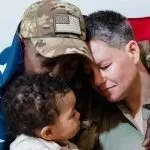Veteran food insecurity is a pressing concern. It affects thousands of former service members and their families across the United States. It’s more common than you might think. This post examines the realities of veteran food insecurity, including causes, consequences, and solutions. We’ll also explore how military life, veteran service, and the overall military community impact food access.
Table of Contents:
- Understanding Veteran Food Insecurity
- Addressing Veteran Food Insecurity
- FAQs about veteran food insecurity
- Conclusion
Understanding Veteran Food Insecurity
Veteran food insecurity involves multiple, intersecting factors. These include the transition to civilian life, financial struggles, limited access to resources, and spouse unemployment. Food insecurity among veterans means struggling to afford enough food for an active, healthy life.
Studies show up to 11.1% of veterans between 18 and 64 experience food insecurity. This highlights the need for veteran families and support food programs. These nutrition programs play a crucial role in fighting hunger among veterans.
Causes of Food Insecurity Among Veterans
Many veterans face difficulty finding stable, well-paying civilian jobs. This can be coupled with mental and physical health challenges that impact their employability. Post-9/11 veterans, in particular, may grapple with service-connected disabilities.
Military spouses often experience job instability due to frequent moves and deployments. Limited food options on military bases can also create challenges in accessing nutritious meals, as reported by Feeding America. Many veterans experience food insecurity because of these factors.
Impact of Food Insecurity on Veterans
Food insecurity has consequences beyond hunger. Veterans may sacrifice nutritional needs to afford any food. This can lead to both mental and physical health problems.
Some veterans must choose between buying medication or food. Food insecurity can lead to homelessness and other hardships for veterans and their families. Accessibility to food pantries and nutrition assistance programs is crucial for veteran families facing food insecurity in rural communities. The veteran family support offered by these charitable food initiatives plays a vital role in keeping these families stable.
Addressing Veteran Food Insecurity
While veteran food insecurity is a significant problem, there are solutions. Support networks play a critical role in combating this issue.
Many cities actively work to reduce veteran homelessness, addressing a critical aspect of food insecurity. Public health initiatives and veteran service organizations also play a vital role in supporting veterans.
Government Programs and Resources
Governmental assistance programs can help veterans experiencing food insecurity. The Supplemental Nutrition Assistance Program (SNAP) is a vital resource.
Nearly 1.2 million veterans rely on SNAP benefits to purchase food (Center on Budget and Policy Priorities). Federal nutrition programs and veteran family support services offer vital resources for food assistance.
The VA’s partnership with the Food is Medicine Coalition aims to deliver healthy meals to veterans’ homes (VA News). A White House initiative also seeks to provide nutritious meals to at-risk veterans nationwide.
The VA established an office of food security to connect struggling veterans with essential services, including financial aid for stable housing. These programs highlight the importance of access to federal nutrition initiatives for veterans facing food insecurity.
Non-profit Organizations and Charities
Non-profits like Move for Hunger connect veterans with broader support systems, including organizations like Feed Our Vets. They also connect veterans with mental and emotional health services through partnerships with organizations like Feeding America.
These non-profits provide food and other forms of life assistance, working to end veteran hunger. Veteran families often rely on charitable food and food pantries. Nutrition assistance is a key element in providing food assistance programs to help eligible veterans buy food and make ends meet.
What You Can Do to Help
Combating veteran food insecurity isn’t solely the responsibility of large organizations. Individuals can contribute too. Volunteering with non-profits like Feeding America is a powerful way to get involved.
Donations to organizations like Feeding America (Donate) directly support their hunger-relief efforts. Advocating for policies that address food insecurity (Advocate) can also make a significant difference.
Sharing information about available resources with those in need helps veterans find assistance programs and SNAP eligibility information. Supporting organizations committed to fighting senior hunger is another crucial way to contribute. Senior veterans often face food insecurity due to financial and mobility challenges. Your involvement can improve food security for Veterans.
FAQs about veteran food insecurity
What percent of veterans are food insecure?
Studies show 1 in 9 working-age veterans are food insecure (USDA’s Economic Research Service). This number varies based on factors like age, location, disability status, and family support.
About 24% of military families reported facing challenges providing food at some point (RAND). These insecurity rates highlight the need for improved nutrition assistance and assistance programs for military members and veterans. These numbers do not include active duty military stationed outside of America on a temporary tour, just American based.
What is the Food Security Act for veterans?
The Food Security Act established the office of food security at the Department of Veterans Affairs. This office aims to reduce veteran food insecurity by connecting veterans with support networks nationwide.
The office leverages the White House National Strategy on Hunger, Nutrition, and Health and works with the VA’s Transition Assistance Program (Food Security for All Veterans Act). This ensures veterans transitioning out of service know about available aid options.
This support is crucial during times of change, like moves and deployments, which can disrupt access to familiar food resources (VA Public Affairs). This assistance aims to help prevent alarming food shortages for military personnel.
Who suffers most from food insecurity?
Veteran food insecurity affects all ages and demographics. However, certain groups experience higher rates. Studies reveal veterans aged 65-74 have higher rates of food insecurity.
Female veterans also experience food insecurity at a higher rate, close to 19%, which is higher than the rate among civilian women. (VA News, Melton). Ensuring these veterans have access to food assistance programs is crucial.
Why are veterans a vulnerable population?
Veterans face unique challenges, particularly during the transition back to civilian life after their service. The process of uprooting and re-establishing lives in new communities creates vulnerability.
The frequent moves and deployments required in military life disrupt routines, jobs, and social connections, especially for spouses, children, and the family overall. It disrupts access to their usual support system from prior locations during their years of service. Health challenges, like PTSD and TBI related to active duty, may make this transition harder (Military Family Advisory Network study).
Veterans and family face adjusting after deployment due to a variety of unique issues faced during military life that lead to a risk for food insecurity (211.org). Resources and food pantries play an important part in getting food assistance to veterans.
There are charitable food programs and VA health resources, such as caregiver support and mental health services available for those veterans that are eligible veterans or even active military members.
Conclusion
Veteran food insecurity is a complex issue, but by understanding the causes and working together, we can make a difference. It is our collective responsibility to ensure veterans have access to basic necessities like food.
Through government programs, non-profits, community involvement, and individual actions, we can support veterans and create positive change. Access to nutrition assistance, health care, and support services is vital for their well-being. Continued efforts to address veteran hunger are essential for honoring their service and sacrifice.


